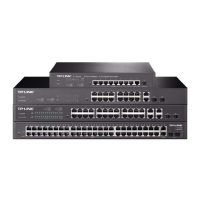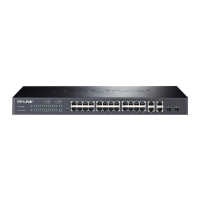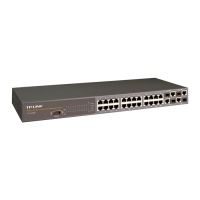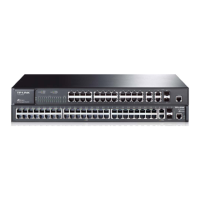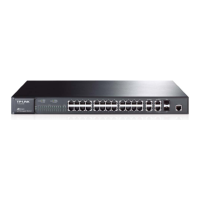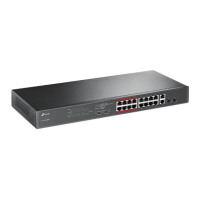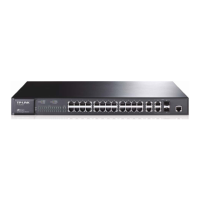Do you have a question about the TP-Link TL-SL2218 and is the answer not in the manual?
Defines the target audience for this user guide, focusing on network managers.
Explains the conventions and symbols used throughout the guide for clarity.
Provides a high-level summary of the guide's structure and content.
Introduces the TL-SL2218/TL-SL2428 Smart Switch, its purpose, and capabilities.
Highlights key features such as resiliency, layer 2 switching, QoS, security, and manageability.
Details the physical layout and components of the switch's front and rear panels.
Describes the components and LEDs located on the front panel of the switch.
Details the components on the rear panel, including power socket and grounding terminal.
Guides users on how to access the switch's configuration utility via a web browser.
Explains how to navigate to the main setup menu after a successful login.
Covers basic system properties: summary, device description, time, and IP settings.
Manages user accounts, passwords, and access levels for web management.
Provides tools for config management, firmware upgrades, reboots, and resets.
Controls user access to the web management page for enhanced security.
Configures basic port features like status, speed, duplex, and flow control.
Configures Link Aggregation Groups for combining ports into a high-bandwidth path.
Monitors traffic statistics for each port to analyze network performance.
Manages MAC address tables, static/dynamic addresses, and filtering.
Explains VLAN tagging and how it identifies packets of different VLANs.
Provides a practical example of configuring 802.1Q VLANs in a network scenario.
Globally configures Spanning Tree Protocol (STP) parameters and versions.
Configures port parameters for Spanning Tree Protocol (STP) for CIST.
Manages Multiple Spanning Tree Protocol (MSTP) instances and VLAN mapping.
Provides protection against malicious attacks targeting STP features.
Demonstrates a practical application example for STP function configuration.
Manages multicast group membership by processing IGMP messages.
Configures multicast IP addresses and their mapping to MAC addresses.
Filters multicast IP ranges to restrict users from joining specific multicast programs.
Monitors multicast data traffic and IGMP messages on each port.
Classifies packets and maps them to priority queues for QoS implementation.
Controls traffic rate and broadcast flow on each port to ensure network stability.
Configures global SNMP, views, groups, users, and communities.
Configures the switch to report important events to the management station.
Provides network monitoring capabilities using RMON groups.
Monitors memory and CPU utilization status via data graphs.
Records, classifies, and manages system information and errors.
Provides tools for device diagnostics like Cable Test and Loopback.
Tests network connectivity and reachability using Ping and Tracert.
Defines the target audience for this user guide, focusing on network managers.
Explains the conventions and symbols used throughout the guide for clarity.
Provides a high-level summary of the guide's structure and content.
Introduces the TL-SL2218/TL-SL2428 Smart Switch, its purpose, and capabilities.
Highlights key features such as resiliency, layer 2 switching, QoS, security, and manageability.
Details the physical layout and components of the switch's front and rear panels.
Describes the components and LEDs located on the front panel of the switch.
Details the components on the rear panel, including power socket and grounding terminal.
Guides users on how to access the switch's configuration utility via a web browser.
Explains how to navigate to the main setup menu after a successful login.
Covers basic system properties: summary, device description, time, and IP settings.
Manages user accounts, passwords, and access levels for web management.
Provides tools for config management, firmware upgrades, reboots, and resets.
Controls user access to the web management page for enhanced security.
Configures basic port features like status, speed, duplex, and flow control.
Configures Link Aggregation Groups for combining ports into a high-bandwidth path.
Monitors traffic statistics for each port to analyze network performance.
Manages MAC address tables, static/dynamic addresses, and filtering.
Explains VLAN tagging and how it identifies packets of different VLANs.
Provides a practical example of configuring 802.1Q VLANs in a network scenario.
Globally configures Spanning Tree Protocol (STP) parameters and versions.
Configures port parameters for Spanning Tree Protocol (STP) for CIST.
Manages Multiple Spanning Tree Protocol (MSTP) instances and VLAN mapping.
Provides protection against malicious attacks targeting STP features.
Demonstrates a practical application example for STP function configuration.
Manages multicast group membership by processing IGMP messages.
Configures multicast IP addresses and their mapping to MAC addresses.
Filters multicast IP ranges to restrict users from joining specific multicast programs.
Monitors multicast data traffic and IGMP messages on each port.
Classifies packets and maps them to priority queues for QoS implementation.
Controls traffic rate and broadcast flow on each port to ensure network stability.
Configures global SNMP, views, groups, users, and communities.
Configures the switch to report important events to the management station.
Provides network monitoring capabilities using RMON groups.
Monitors memory and CPU utilization status via data graphs.
Records, classifies, and manages system information and errors.
Provides tools for device diagnostics like Cable Test and Loopback.
Tests network connectivity and reachability using Ping and Tracert.
| Switching Capacity | 36 Gbps |
|---|---|
| Forwarding Rate | 26.78 Mpps |
| MAC Address Table | 8K |
| Jumbo Frame | 9KB |
| Dimensions (W x D x H) | 440 x 180 x 44 mm |
| Fan Quantity | Fanless |
| Power Supply | 100-240VAC, 50/60Hz |
| Switching Capacity (Alternative) | 36 Gbps |
| Packet Forwarding Rate | 26.78 Mpps |
| Standards and Protocols | IEEE 802.3, IEEE 802.3u, IEEE 802.3x |
| Network Media | 10BASE-T: UTP Cat. 3, 4, 5 (100m max), 100BASE-TX: UTP Cat. 5, 5e (100m max), 1000BASE-T: UTP Cat. 5, 5e (100m max) |
| QoS | SP+WRR |
| VLAN | Port-based VLAN |
| IGMP Snooping | IGMP v1/v2/v3 snooping |
| Management | Web-based GUI |
